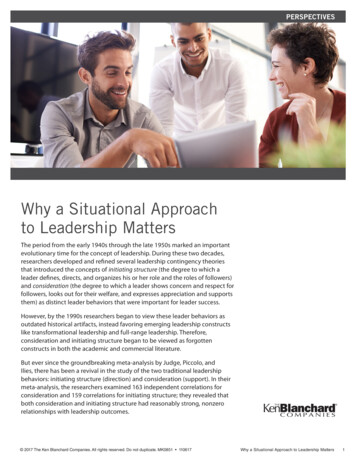
Transcription
C H A P T E R2 5THE HOW, WHY, WHAT, WHEN, ANDWHO OF HAPPINESSMechanisms Underlying the Success of Positive Activity InterventionsKRIS TI N LAYOUS, & SONJA LYUBOMIRSKYMost people want to be happy (Diener, 2000) and they seek happiness in a variety ofways—through achieving greater income or more prestigious careers, living walking distance to the ocean, or buying a shiny new car. Evidence suggests, however, thatchanging one’s life circumstances (e.g., marital status, career, location, and income)is not the most fruitful path to greater well-being (Sheldon & Lyubomirsky, 2006a). Instead,simple cognitive and behavioral strategies that people can employ in their daily lives have beenfound to reliably improve happiness (Sin & Lyubomirsky, 2009), including its hallmark, positiveemotions (Diener, Sandvik, & Pavot, 1991; Urry et al., 2004). These strategies do not involvemaking major shifts to people’s current life situations and can be used by anyone, regardless oftheir genetic make-up. Although possessing the capacity to increase one’s own happiness maysound too good to be true, the development and understanding of happiness-boosting strategies have come a long way since Fordyce (1977, 1983) published his first successful attempts atintentionally increasing happiness levels in his classrooms. Since that time, research has accumulated to convincingly suggest that a large portion of happiness may be under people’s controlthrough the activities they choose and how they construe and respond to situations in their lives(Lyubomirsky, Sheldon, & Schkade, 2005).A common argument from skeptics is that people’s happiness levels are genetically determined and cannot be substantively changed. Despite persuasive evidence from twin studies thatwell-being levels are strongly influenced by genetics (Lykken & Tellegen, 1996), more recentresearch suggests that genetic influences on happiness might be weaker than originally thought,with environmental influences explaining a large portion of individual differences in happiness (Røysamb, Harris, Magnus, Vittersø, & Tambs, 2002; Stubbe, Posthuma, Boomsma, & deGeus, 2005). Furthermore, research on gene-environment interactions suggests that biology and25 9780199926725c25.indd 4739/21/2013 12:41:46 PM
474JUST RIGHT: CULTIVATING HEALTHY POSITIVE EMOTIONenvironment continuously interact in a dynamic process to influence people’s behavior, so evengenetic predispositions are not deterministic (Plomin, 2004).Studies also show that the relationship between people’s life circumstances (e.g., theirincome, relationship status, or health) and their happiness is not as strong as intuition wouldsuggest (Diener, Suh, Lucas & Smith, 1999). For example, the fulfillment of one’s basic psychological needs (autonomy, competence, and relatedness; Deci & Ryan, 2000) is a better predictorof daily positive and negative emotions than one’s income (Diener, Ng, Harter, & Arora, 2010).Also, although people do receive an emotional boost from a highly positive event such as gettingmarried, these initial boosts do not last indefinitely (Lucas, Clark, Georgellis, & Diener, 2003), aspeople tend to adapt to their life circumstances over time (i.e., to experience hedonic adaptation;Lyubomirsky, 2011). Such findings suggest that trying to become happier by improving one’s lifecircumstances—if those circumstances are not dreadful to begin with—is unlikely to pay off.Although individual differences in biology and circumstances combine to explain part ofthe happiness puzzle, a gap exists in the explained variance (Lyubomirsky, Sheldon, et al., 2005).For example, people’s happiness levels have been found to shift over time. In a 17-year longitudinal study, 24 percent of participants showed substantive changes in their happiness over time,with 9 percent changing by over two standard deviations (Fujita & Diener, 2005). Theory andresearch supporting hedonic adaptation suggest that even substantial changes in people’s life circumstances (e.g., marriages, divorces, job layoffs; Luhman, Hofman, Eid, & Lucas, 2012) do notlead to such sustained shifts in well-being. We argue instead that these observed changes can beexplained in part by deliberate ways that people choose to think and behave in their daily lives.How and why these practices and habits can “work” to shift well-being has been the focus of ourlaboratory’s efforts for over a decade.HOW CAN WELL-BEING BE INCREASED?Positive activity interventions (PAIs) involve simple, self-administered cognitive behavioralstrategies designed to mirror the thoughts and behaviors of naturally happy people and, inturn, improve the happiness of the person performing them. A number of PAIs have alreadyestablished their effectiveness in increasing well-being and/or reducing negative symptoms inrandomized, controlled interventions. They include (but are not limited to) writing letters ofgratitude (Boehm, Lyubomirsky, & Sheldon, 2011a Layous, Lee, Choi, & Lyubomirsky, 2012;Lyubomirsky, Dickerhoof, Boehm, & Sheldon, 2011; Seligman, Steen, Park, & Peterson, 2005);counting one’s blessings (Chancellor & Lyubomirsky, 2012; Emmons & McCullough, 2003; Froh,Sefick, & Emmons, 2008; Lyubomirsky, Sheldon, et al., 2005; Seligman et al., 2005); practicingoptimism (Boehm et al., 2011a; King, 2001; Layous, Nelson, & Lyubomirsky, 2012; Lyubomirskyet al., 2011; Sheldon & Lyubomirsky, 2006b); performing acts of kindness (Della Porta, JacobsBao, & Lyubomirsky, 2012; Dunn, Aknin, & Norton, 2008; Sheldon, Boehm, & Lyubomirsky,2012; Study 2); using one’s strengths in a new way (Seligman et al., 2005); affirming one’s mostimportant values (Nelson & Lyubomirsky, 2012a); and meditating on positive feelings towardsself and others (Fredrickson, Cohn, Coffey, Pek, & Finkel, 2008). These activities are similar inthat they are all relatively brief, self-administered, and non-stigmatizing exercises that promotepositive feelings, positive thoughts, and/or positive behaviors, rather than directly aiming to fixnegative or pathological feelings, thoughts, and behaviors. For example, in one positive activity,people are instructed to spend 8 to 10 minutes writing a gratitude letter to someone who has25 9780199926725c25.indd 4749/21/2013 12:41:48 PM
Success Mechanisms of Positive Activity Interventions475been kind to them. No restrictions about letter format or to whom the letter should be writtenare provided. Participants are encouraged to describe in detail what that person has done forthem and how it has affected their lives. Some researchers have encouraged their participantsto deliver their letter(s) (Froh et al., 2008; Seligman et al., 2005), whereas others specify that theletter(s) remain unshared (Boehm et al., 2011a; Lyubomirsky et al., 2011). Both types of experiments have shown positive effects for the letter writer. Although other positive activities vary incontent and practice, they are equally uncomplicated and take relatively little time to perform.A growing body of evidence is showing that happiness-increasing strategies do stimulateincreases in well-being. An oft-cited meta-analysis of 51 positive interventions overwhelminglyrevealed that positive interventions significantly increase well-being (mean r .29) and alleviatedepressive symptoms (mean r .31; Sin & Lyubomirsky, 2009). In practical terms, this meansthat out of 200 individuals—100 of whom are randomly assigned to practice a positive activityand 100 to perform a neutral control activity—64 of the individuals in the positive activity groupwill increase in well-being, compared to only 36 individuals in the control group.To put these effect sizes into perspective, the classic Smith and Glass (1977) meta-analysis of375 psychotherapy studies found that psychotherapy demonstrated an average effect size r of.32for outcomes like self-esteem and adjustment. The Sin and Lyubomirsky (2009) meta-analysisstrongly supports the overall efficacy of positive interventions; however, it also revealed thatseveral variables moderated the effectiveness of the activities. These results highlight the importance of establishing the optimal conditions for positive activity interventions (e.g., duration,intervention format), as well as identifying the personal characteristics of participants (e.g.,self-selection, initial depression status) that might predict maximum success.Current and future research would do well to move beyond simply focusing on whetherPAIs can increase well-being. They can. Today’s pressing questions involve understanding themechanisms underlying the success of happiness-increasing interventions. Fortunately, a greatdeal of ground has already been covered in researchers’ understanding of the how, why, what,when, and who of the success of PAIs; or, more formally, the moderators and mediators underlying the efficacy of happiness-boosting strategies. This chapter will provide an overview of whathas already been learned about the boundary conditions of happiness-increasing strategies, aswell as what remains to be investigated. First, we review the psychological processes by whichpositive activities work to improve well-being. These four mediators are depicted at the top ofthe positive activity model (Lyubomirsky & Layous, in press; see Figure 25.1), which illustratesthe theoretical framework guiding the research described in this chapter. Second, we discuss thecharacteristics of a particular activity that may enhance its probability of success (e.g., its timingand variety; see Figure 25.1, bottom left) and the characteristics of the individual that may leadhim or her to benefit more from performing positive activities (e.g., motivation, effort, socialsupport, culture, age, and baseline levels of well-being; see Figure 25.1, bottom right). Lastly, wedescribe the intersection between the positive activity and the individual that might produce anoptimum “person-activity fit” (see Figure 25.1, bottom center).HOW DO POSITIVE ACTIVITY INTERVENTIONS WORK?Although ample evidence exists to suggest that positive activity interventions are successful inincreasing well-being, many questions remain about the process through which positive activities work. Lyubomirsky and Layous (in press) have started to dissect the potential mechanisms25 9780199926725c25.indd 4759/21/2013 12:41:48 PM
476JUST RIGHT: CULTIVATING HEALTHY POSITIVE EMOTIONunderlying the success of happiness-increasing activities. They theorize that prompting peopleto perform positive activities leads them to have more positive emotions, positive thoughts,positive behaviors, and greater satisfaction of basic psychological needs (Deci & Ryan, 2000;Sheldon, Elliot, Kim, & Kasser, 2001), which, in turn, serve to increase well-being (see top ofFigure 25.1).Preliminary analyses have supported the mechanisms proposed in the positive activity model. One study found that the relationship between engaging in positive activities andimprovements in well-being was mediated by perceived increases in satisfying experiences(Dickerhoof, 2007). Notably, in each week of the study, participants listed three memorableexperiences and independent coders rated these experiences as becoming less (rather thanmore) satisfying over time, indicating that engaging in positive activities made the participantsconstrue their objectively less-than-positive experiences more charitably and optimistically(i.e., boosting positive thoughts; Dickerhoof, 2007). Another study showed that increases inpositive emotions experienced as a result of a meditation activity fostered personal resourcessuch as social relationships and physical health, which, in turn, increased life satisfaction(Fredrickson et al., 2008). Furthermore, positive activities have been shown to increase positive behaviors that are unrelated to the activity itself. For example, people who counted theirblessings (a gratitude activity) exercised more than people who listed daily hassles (Emmons& McCullough, 2003).Recent evidence also supports need satisfaction as an important mediator underlying thelink between positive activities and boosts to well-being. One study showed that expressinggratitude and optimism increased the need satisfying feelings of relatedness and autonomy (butnot competence), which, in turn, increased well-being (Boehm et al., 2011b). Paralleling theseresults, students prompted to engage in goals that would enhance their autonomy or relatedness increased in well-being over a six-month period more than students prompted to changesomething about their life circumstances (Sheldon et al., 2010). Students prompted to engage ingoals that would enhance their competence, however, did not show relative gains in well-being(Sheldon et al., 2010). Finally, a six-week intervention that combined instructions to performacts of kindness with delivery of autonomously supportive messages from peers boosted theparticipants’ perceived autonomy or choice, which, in turn, predicted increases in their happiness and decreases in negative affect (Della Porta et al., 2012).In sum, studies provide preliminary evidence for each of the proposed mediators in thepositive activity model (see Figure 25.1). More research is needed to test this model and to lookfurther into the role of need satisfaction (autonomy, relatedness, and competence; Deci & Ryan,2000; Sheldon, Elliot, Kim, & Kasser, 2001), as well as the three other categories of hypothesizedmediation variables (e.g., positive thoughts, positive emotions, and positive behaviors).Researchers have also begun to posit the neural mechanisms by which positive activitiesmight serve to improve well-being and decrease depressive symptoms (Layous, Chancellor,Lyubomirsky, Wang, & Doraiswamy, 2011). Affective neuroscientists have accumulated twodecades of evidence suggesting that people with depression demonstrate hyperfunctioning limbic systems (e.g., Mayberg et al., 1999; Siegle, Thompson, Carter, Steinhauer, & Thase, 2007),hypofunctioning dorsal cognitive control systems (e.g., Mayberg et al., 1999; Siegle et al., 2007),and a relatively reduced response in reward-related neural circuitry (e.g., Heller et al., 2009;Pizzagalli et al., 2009). Whereas pharmacotherapy has been shown to downregulate limbichyperactivity and cognitive behavioral therapy has been shown to improve cognitive control, nocurrent therapy has focused directly on upregulation of the reward system.25 9780199926725c25.indd 4769/21/2013 12:41:48 PM
Success Mechanisms of Positive Activity Interventions477Although, to our knowledge, no studies of PAIs have incorporated the use of brain scantechnologies, researchers predict that engaging in positive activities might increase the responseof depressed individuals to reward-relevant stimuli (i.e., after practicing positive activities, people with depression will exhibit the appropriate neural response to a piece of chocolate or avictory). Possibly, when combined with drug and cognitive behavioral therapy, the practice ofpositive activities might provide the missing component to a well-integrated treatment programthat focuses on addressing all of the abnormalities in neural functioning characteristic of peoplewith depression (Layous et al., 2011). Alternatively, the practice of positive activities alone mightserve to help the 70 percent of reported cases of depression that do not receive the recommended level of treatment (National Institute of Health, 2008). Before recommending the practice of positive activities to people with depression, however, randomized controlled trials needto be conducted comparing PAIs to pharmacotherapy and talk therapy. The neural mechanismsunderlying the success of positive activities in healthy individuals also need research attention.CHARACTERISTICS OF POSITIVE ACTIVITIESTHAT MAY IMPACT THEIR EFFICACYTIMING AND DOSAGEFeatures of positive activities—including their timing, dosage, and variety—all influence theireffectiveness (see bottom left of Figure 25.1). To begin, when patients take prescription drugs,the pharmacist explains the correct dosage or timing of the medication to make it optimallyeffective—for example, “take three pills immediately, and one per day for a week after that.”Preliminary research suggests that “dosage” and “timing” matter in PAIs too. In one study, participants were asked to perform five acts of kindness either all in one day or spread out overthe course of the week. Participants who performed the kind acts all in one day showed greaterincreases in well-being than those who performed kind acts throughout the week (Lyubomirsky,Sheldon, et al., 2005). This finding indicates that particular packagings of PAIs might make themrelatively more effective.Similarly, another study showed that participants who counted their blessings only once perweek for six weeks saw greater gains in well-being than participants who counted their blessingsthree times per week (Lyubomirsky, Sheldon et al., 2005). This result suggests that performinga positive activity too much during the course of a week might make it burdensome and therefore diminish the benefits. On the other hand, a naturalistic study examining people’s everydaypursuit of happiness found that, on average, people perform their chosen happiness-increasingstrategies several times a week for at least an hour each time (Parks, Della Porta, Pierce, Zilca,& Lyubomirsky, 2012 Study 2). Moreover, people who voluntarily engaged in positive activities through an application on their iPhones reported greater increases in well-being the morefrequently they logged into the application (Parks et al., 2012, Study 3). Although these findingsmight initially appear contradictory, they suggest that the optimum frequency for practicingpositive activities may vary depending on whether the happiness-seeker is voluntarily engagingin a self-chosen activity versus one mandated by an investigator.The length of an intervention may also bolster the benefits garnered from performing aparticular activity, such that the longer the intervention, the greater the increase to well-being25 9780199926725c25.indd 4779/21/2013 12:41:49 PM
478JUST RIGHT: CULTIVATING HEALTHY POSITIVE EMOTION(Sin & Lyubomirsky, 2009). Because the majority of the interventions highlighted in the 2009meta-analysis were between 4 and 10 weeks long, they may not have been long enough toobserve potential hedonic adaptation, whereby the rewards of an activity subside with time. Wepredict a curvilinear relationship between increases in well-being and the length of the intervention over time, if the same positive activity is performed without any variation, as people maybecome bored with a single positive activity and experience less of the initial boost in positiveemotions they once experienced.VARIETYOne of the chief obstacles to people’s attempts to sustainably increase their happiness is theirremarkable capacity to adapt to almost all positive changes (Brickman & Campbell, 1971;Frederick & Loewenstein, 1999; see Lyubomirsky, 2011, for a review). As just two persuasiveillustrations of such hedonic adaptation, two studies showed that both newlyweds (Lucas et al.,2003) and high-level managers with new promotions (Boswell, Boudreu, & Tichy, 2005) eventually adapted to their respective positive life change and returned to baseline levels of well-being.If people adapt to positive circumstantial changes, they might adapt to the practice of positive activities over time as well. Lyubomirsky and her colleagues (Lyubomirsky, 2011; Sheldon,Boehm, & Lyubomirsky, 2012) propose that one way to inhibit or slow down adaptation to positive experiences or activities is by bolstering variety.Theory and research suggests that variety in thoughts and behaviors is inherently motivatingand rewarding (Berlyne, 1970; Pronin & Jacobs, 2008; Rolls et al., 1981). College students reportbeing less likely to adapt to dynamic life changes (e.g., those that involve continued engagementin a variable, self-directed process, like taking a language class or making a new friend) than tostatic ones (e.g., acquiring a better dorm room or more financial aid; Sheldon & Lyubomirsky,2006a; Study 1). Furthermore, people are slower to adapt to positive stimuli that are varied thanthose that are stable (Leventhal, Martin, Seals, Tapia, & Rehm, 2007).For example, consider a young person who receives a Wii gaming system as a present. Ifthe Wii includes only one game, the initial positive emotions gained from playing with thenew console will be short-lived, and boredom with the one game will quickly ensue. However,if the Wii is loaded with a variety of games, with multiple levels, and the ability to play withmultiple different people, the combinations of games, levels, and players will vary each timethe individual uses his gift. Introducing variety into the activity of playing the Wii leads thepositive emotions of the initial positive experience to last much longer than it would haveotherwise.Similarly, with respect to positive activities, if an individual intends to become happier bypracticing only one activity (say, counting blessings or doing acts of kindness) for several weeksor months, she is likely to tire of the activity over time, experiencing fewer and weaker positiveemotions from each subsequent week of performing the activity. Indeed, a study investigatinghow people pursue happiness in the real world (i.e., outside of a randomized controlled intervention) found that people perform between seven and eight activities to improve their ownhappiness at any one time (Parks et al., 2012, Study 2). Furthermore, in another study, thosewho voluntarily purchased a happiness-increasing iPhone app saw greater increases in moodand overall happiness if they practiced multiple positive activities as opposed to just one (Parkset al., 2012, Study 3).25 9780199926725c25.indd 4789/21/2013 12:41:49 PM
Success Mechanisms of Positive Activity Interventions479In sum, these findings suggest that varying the practice of any one positive activity couldalso serve to prolong its positive effects. In a test of this hypothesis, Sheldon and colleagues(2012; Study 2) found that people instructed to perform different acts of kindness each week(e.g., do a new household chore one week, surprise their pet with a treat another week) showedlarger gains in well-being than those instructed to perform the same acts of kindness (e.g., donew household chores each week). In a separate study, Sheldon and colleagues (2012; Study1) asked participants to make a positive life change (e.g., walking to work each day). Thosewho reported that their life change varied over time (e.g., they varied their daily route to work)showed sustained increases in well-being at a follow-up assessment relative to those who didnot report variety. These results indicate that happiness researchers may need to consider thepotential routineness and monotony of PAIs as an obstacle to increases in well-being.CHARACTERISTICS OF PERSONS THAT MAYIMPACT THE EXTENT TO WHICH THEY BENEFITThe PAIs we have highlighted have shown positive overall effects on participant well-being.Analyses of the data beyond simple averages, however, reveal that PAIs work better for someindividuals than others. Accordingly, researchers may find it instructive to consider the characteristics of persons that make them more or less likely to benefit from practicing a positiveactivity (see Figure 25.1, bottom right).MOTIVATION AND BELIEFSAdmittedly, some positive activities might sound cliché or corny and may deter skeptics fromengaging in them in a meaningful way. Two important components of the success of PAIs inraising well-being are the participant’s motivation to seriously engage in the target activity andher belief that the activity could work to enhance well-being. We speculate that an individualwho self-selects into a PAI is both motivated to become happier and believes in the targetactivity’s efficacy. Indeed, participants who self-select into positive interventions have beenfound to show larger gains in well-being and larger decreases in depressive symptoms thanthose who do not self-select (Sin & Lyubomirsky, 2009). For example, a study that recruitedparticipants through an advertisement in one of the authors’ self-help books, thus capturingindividuals who had already taken steps to improve their mental health, showed impressiveincreases in well-being and decreases in depressive symptoms among those engaging in asimple activity for just a week (Seligman et al., 2005). In an experimental manipulation of thisfactor, Lyubomirsky, Dickerhoof, and colleagues (2011) found that after performing a positive activity, participants who initially self-selected into an intervention ostensibly designedto make them happier showed greater gains in well-being than those who self-selected to “testcognitive exercises.” This experiment established self-selection as an important moderator ofthe efficacy of PAIs. Although, to our knowledge, motivation to become happier and beliefsin the efficacy and benefits of happiness-seeking activities have not been directly measuredand manipulated, we expect these variables to relate to gains in well-being following positiveactivities.25 9780199926725c25.indd 4799/21/2013 12:41:49 PM
480JUST RIGHT: CULTIVATING HEALTHY POSITIVE EMOTIONThe above evidence suggests that participant motivation to become happier might be animportant component in the success of PAIs. Other evidence, however, indicates that havingthe goal of happiness might have deleterious outcomes. For example, in a cross-sectional study,people who valued happiness more were actually less happy when facing low levels of life stress,likely because stressors were not present to account for negative emotions experienced (Mauss,Tamir, Anderson, & Savino, 2011; Study 1). Experimentally inducing participants to value happiness through a fake newspaper article that extolled the virtues of happiness showed similarresults. Participants led to value happiness actually experienced less happiness from a positivevideo clip than participants who read an affectively neutral news clip (Mauss et al., 2011; Study2). Furthermore, feelings of disappointment mediated the relationship between valuing happiness and emotions experienced. The authors reasoned that pursuing happiness as a goal is notthe same as pursuing a goal such as high grades. If a student does not attain the grade for whichshe was striving, she will likely be disappointed, but she may at least earn a satisfactory grade,and thus will still have achieved part of her goal. Feeling disappointed at not reaching the goalof happiness, however, is a direct threat to happiness.The implication from the Mauss and colleagues (2011) studies is that being highly motivatedto become happier serves as a barrier to real happiness. Support for this notion can be foundin traditional Buddhist thought, as Buddhism stipulates that true happiness is achieved whenyou renounce your individual happiness. Indeed, increased self-monitoring and self-focus haveoften been associated with lower well-being (Gruber et al., 2011; Lyubomirsky, Boehm, Kasri, &Zehm, 2011). Despite the potential pitfalls of being too motivated to be happy, most Westernerslist happiness as an important goal (Diener, 2000), so it is important that researchers understand the relationship between motivation to become happier and experienced happiness. Howcan the seemingly contradictory findings about the effects of directly pursuing happiness bereconciled?Although designed to make people happier, the precise practice of PAIs does not direct thepractitioners’ attention on their own happiness. Instead, people are encouraged to follow specific instructions for concrete cognitive or behavioral activities that are often other-focusedin nature (e.g., writing letters of gratitude or performing acts of kindness for others) or toseek to indirectly increase happiness through providing a need satisfying experience (Boehm,Lyubomirsky, & Sheldon, 2011b; Layous et al., in press). Also, the transient positive emotioninduction used in Mauss and colleagues’ second study (2011) cannot be generalized to thedynamic, longitudinal, naturalistic happiness-seeking strategies that people may employ intheir daily lives. Nevertheless, exploring the potential negative impact of being motivated tobecome happier is a vital contribution to the literature and needs to be studied further in thecontext of PAIs.EFFORTPeople are often taught that if they want something, they have to work for it. This adage seems to betrue for increasing happiness as well. For example, one reason that motivated happiness-seekersare more successful than their less motivated peers is that they are willing to put more effort intoa positive activity. Supporting the critical role of effort, a six-week PAI found that self-reportedparticipant effort predicted linear increases in well-being over the course of the study (Layous,Lee, et al., 2012), and, in a six-week workplace intervention, the number of characters written25 9780199926725c25.indd 4809/21/2013 12:41:49 PM
Success Mechanisms of Positive Activity Interventions481(an indicator of effort) during a gratitude-focused activity also predicted increases in well-being(Chancellor & Lyubomirsky, 2012).In another study, independent coders read participants’ written entries (descriptions of theirbest possible selves, letters of gratitude, or lists of what they did over the last 24 hours) and ratedthe level of effort they put into completing the activity (Lyubomirsky, Dickerhoof, et al., 2011).Coder-rated effort predicted increases in well-being in the positive activity conditions, but notin the neutral activity condition. This finding suggests that when effort toward becoming happier is well-placed—in an experimentally tested positive activity—it can result in increases towell-being. However, when effort is put toward a neutral activity, these same boosts do not
the happiness puzzle, a gap exists in the explain ed variance (Lyubomirsky, Sheldon, et al., 2005). For example, people’s happiness levels have been found to shift over time. In a 17-year longitu-dinal study, 2



![[Page 1 – front cover] [Show cover CLEAN GET- AWAY 978-1 .](/img/13/9781984892973-6648.jpg)







